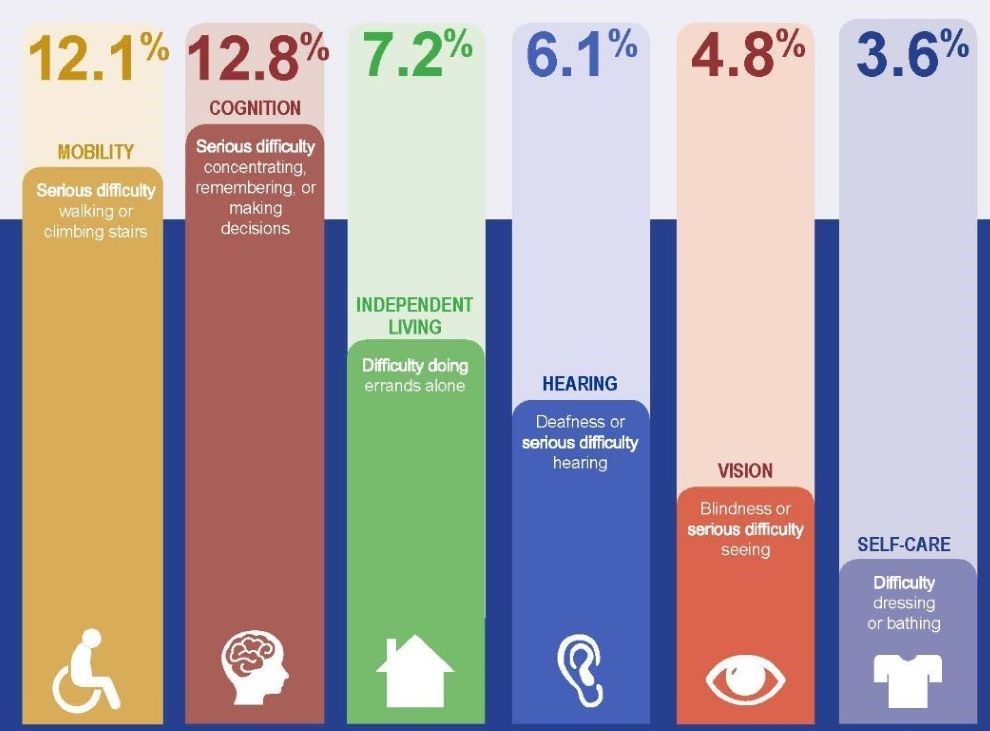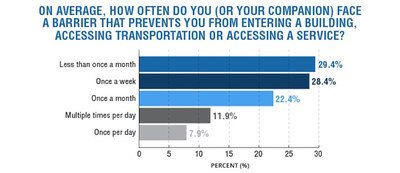Understanding Accessibility Guidelines for Facilities: How Can You Make a Difference

Have you ever taken a moment to truly think about the impact of accessibility in facilities and in your everyday lives? It often goes unnoticed, but its significance becomes strikingly clear when you stop and observe the world around you.
Think about it. Around 16% of the world’s population and 26% of people in the U.S. face various disabilities, according to the World Health Organization and the CDC. That’s over 1 billion individuals worldwide and 86 million in the U.S.

Source:CDC
Imagine individuals’ obstacles and limitations when buildings and facilities neglect to consider accessibility in their design.

Source:Disabled World
As a facility manager, understanding and implementing accessibility measures in your facilities is not just about meeting legal requirements; it’s about creating a more inclusive and equitable space. It’s about opening doors for everyone, regardless of their abilities.
In this blog, we’ll explore what accessibility means in the context of facilities management and the practical steps you can take to ensure your facility remains in compliance with the guidelines and standards set by the Americans with Disabilities Act (ADA) for buildings and facilities. Addressing accessibility is not just about meeting legal requirements—it’s about recognizing and responding to core facilities management challenges, such as creating inclusive spaces, retrofitting older infrastructure, and training staff to support individuals with varying needs. More than rules, it’s about fostering empathy and truly understanding the challenges faced by individuals with disabilities.
ADA Demystified: What it is, Embracing Inclusion in Your Facilities
The ADA grants individuals with disabilities the right to access facilities like public places, including offices, restaurants, hotels, and retail stores. Facility owners and managers are responsible for removing barriers and providing reasonable accommodations to ensure equal access.
Understanding the importance of ADA in facility planning is crucial for facility managers. By complying with the ADA, facility owners not only meet legal obligations but also tap into next level of customer first approach. People with disabilities represent a substantial consumer base, and by making your facility accessible, you open doors to increased customer satisfaction and loyalty.
Note- While it is critical to comply with local or state codes from accessibility guidelines for facilities, it is crucial to understand that compliance with these codes does not necessarily guarantee compliance with the ADA. A thorough understanding of the specific requirements outlined in the ADA is essential to ensure comprehensive accessibility and inclusion for individuals with disabilities.
Creating Inclusive Spaces: Key Accessibility Guidelines and Requirements under the ADA
Ensuring accessibility for individuals with disabilities is a moral imperative and a legal obligation under the Americans with Disabilities Act (ADA). To make sure everyone can access and participate, it’s essential to understand what the ADA means for facility managers and what are the accessibility guidelines for facilities and buildings. By following the guidelines set by the ADA, facilities can create inclusive spaces that accommodate diverse needs. Below we will explore various aspects of accessibility and the specific ADA requirements that facility managers need to meet to promote equal access and inclusion.
Opening Doors to All: Entrance and Exit Accessibility:
“To ensure inclusivity, it is crucial to provide accessible entrances and exits that allow individuals with disabilities to enter and exit buildings independently,” says Leah Riley, a senior building code consultant. “Many facility managers overlook the need to update older buildings to meet current ADA regulations.”
Leah Riley suggests practical steps to improve accessibility in older buildings, such as “adding curb cuts to sidewalks and entrances, widening doors, and attaching accessible hardware to facilitate easy entry.” Additionally, she emphasizes the importance of “eliminating high pile carpet and arranging office furniture in a way that promotes accessibility.”
Taking additional practical steps can further enhance accessibility in facilities by removing barriers and improving inclusivity. Install ramps or elevators to ensure easy and safe access to different building levels for individuals who use wheelchairs or have mobility impairments.
Design doorways wide enough to accommodate wheelchairs and other mobility devices, with accessible handles or controls that can be easily integrated with building access control systems.
By addressing these entrance and exit considerations, businesses and facilities can create an environment that embraces inclusivity and equal opportunity for all individuals.
Navigating with Ease: Signage and Wayfinding:
Implementing clear signage and wayfinding systems that are easy to read and understand, enabling individuals with visual impairments to navigate buildings independently.
One approach uses high-contrast colors and large, legible fonts on signs to enhance visibility and readability for individuals with visual impairments.
In addition, incorporating tactile elements such as Braille or raised lettering on signs and informational displays can significantly assist individuals who are blind or have low vision.
For instance, journalist Sophie Weiner highlights in her article at Hopes & Fears that concert and conference venues can consider installing viewing platforms to accommodate disabled individuals in large crowds. These platforms help visually impaired people see performances and assist those with hearing impairments in orienting themselves and staying engaged with the show or speaker.
By incorporating these strategies, businesses and facilities can enhance accessibility, allowing individuals with disabilities to navigate buildings confidently and independently.
Restrooms for All: Ensuring Accessibility and Dignity:
“To ensure true accessibility and dignity, it is essential to go beyond simply labeling restrooms as wheelchair accessible,” highlights Joan Eisenstodt, a meeting design consultant. “Ample space for a wheelchair to turn around and other hardware considerations must be taken into account.”
According to the UK evaluation company DisabledGo, accessible restrooms should also include hoists and changing benches to accommodate individuals with specific needs. Changing Places, a specialized organization advocates for designing toilets that cater to individuals with various conditions such as multiple sclerosis, cerebral palsy, motor neuron diseases, and reduced mobility in older people.
Caregiver support specialist company Elizz emphasizes the importance of grab bars and wheelchair-accessible sinks in restrooms. Additionally, the proximity and ease of access to bathrooms are critical considerations for individuals facing mobility challenges, as pointed out by Dee McCurry at the conference management company Ex Ordo.
These insights highlight the importance of designing restrooms that meet the diverse needs of individuals with disabilities, ensuring spaciousness, appropriate hardware, and accessibility features to promote comfort, independence, and inclusivity.
Parking with Purpose: Accessible Parking Facilities:
Accessible facility design plays a pivotal role in promoting inclusivity and equal access. Designing parking facilities with accessibility in mind is crucial for fostering inclusivity and ensuring equal access for individuals with disabilities. By implementing the principles of universal design, you can create parking spaces that accommodate a broad range of abilities and enhance the overall accessibility of the facility.
To achieve this, it is essential to:
- Designate accessible parking spaces that are appropriately sized, conveniently located, and marked with appropriate signage.
- Reserve accessible parking spaces solely for individuals with disabilities to provide convenience and proximity to building entrances.
- Create accessible pathways that are free from obstacles, curbs, or steps, allowing individuals with disabilities to navigate the parking area with ease.
By understanding and implementing the ADA regulations and guidelines, businesses and facilities can ensure they meet the key requirements for creating inclusive and accessible spaces. This approach fosters a sense of dignity, independence, and equal opportunity for all individuals.
For more, detailed insights, you may refer to-
ADA Standards for Accessible Design
ADA Accessibility Standards
ADA Checklist for Existing Facilities
Beyond Compliance: Continuous Improvement in Facilities Management
As facility managers, you often navigate the complex landscape of regulations and guidelines. Compliance is undoubtedly crucial; after all, it ensures the safety, accessibility, and sustainability of your buildings. But have you ever wondered if there’s more to it? Is there a way to go beyond compliance and strive for continuous improvement?
A robust facility management system software can streamline compliance with evolving ADA regulations. Conduct regular audits, gather feedback from the community, embrace diversity, and create an inclusive digital experience to go beyond compliance and prioritize accessibility in facilities management.
Stay Up-to-Date: Evolving ADA Regulations and Guidelines
Let’s start by acknowledging the ever-evolving nature of regulations and guidelines, especially those set forth by the Americans with Disabilities Act (ADA). As facility managers, you know that accessibility is not just a checkbox to tick—it’s a fundamental aspect of inclusive facilities management.
Keeping up with the latest ADA standards is an ongoing process and a key part of facility management best practices. It requires you to stay informed, adapt, and ensure that your properties meet the latest requirements. By doing so, you not only comply with the law but also demonstrate your commitment to inclusivity and create spaces that are accessible to everyone.
Audit for Success: Regular Reviews and Assessments
Now, let’s talk about audits. They may sound intimidating, but they are a powerful tool for continuous improvement. Regularly reviewing and assessing your buildings, systems, and processes allows you to identify areas where you can enhance performance and efficiency.
By conducting comprehensive audits with FieldCircle, a facility maintenance software, you gain a better understanding of your facility’s strengths and weaknesses.
You can pinpoint opportunities for improvement, whether it’s optimizing energy usage, refining maintenance protocols, or enhancing the overall experience for your occupants. Audits empower you to make data-driven decisions and ensure your facilities operate at their best.
Voices of Inclusion: Gather Feedback from the Community
Facilities don’t exist in isolation; they are vibrant spaces that serve a diverse community. To foster inclusivity, you must actively seek input from the people who use and benefit from your facilities. Engaging with occupants, visitors, and stakeholders opens the doors to valuable insights and perspectives.
Feedback can come in various forms – a survey, a suggestion box, or even a friendly conversation. By creating avenues for the community to voice their thoughts, you better understand their needs, preferences, and concerns. This feedback becomes the foundation for driving continuous improvement and tailoring your facilities to meet diverse needs effectively.
Embrace Diversity in Facilities
Inclusion isn’t just about checking diversity boxes; it’s about creating a culture where everyone feels valued and empowered.
By embracing diversity in your hiring practices, you bring together a team with a rich tapestry of backgrounds, experiences, and perspectives. This diversity fuels innovation, creativity, and problem-solving within your facilities. It’s about recognizing that embracing your differences creates a collaborative environment where everyone’s voice is heard and respected.
Create an Inclusive Digital Experience: Bridging Communication Gaps
Lastly, effective communication is the lifeblood of any successful facility. Clear and transparent channels ensure that occupants are well-informed and can easily navigate the facility.
To enhance communication, you can leverage technology – digital signage, mobile applications, or virtual assistants – to provide real-time updates and important information. Moreover, you must prioritize information accessibility for individuals with disabilities.
From providing alternative formats for documents to ensuring your digital platforms meet accessibility standards, you can bridge communication gaps and ensure everyone has equal access to information.
Inspiring Examples of Accessibility Implementation
It’s interesting to observe how successful accessibility initiatives have transformed spaces, making them more inclusive and user-friendly. By exploring these real-world examples, you can reflect on your practices and gain valuable insights to create welcoming environments for everyone you serve. Let’s dive in and discover the power of accessibility together.
Opening Doors to Equal Opportunities
Monica Ponce de Leon, dean of the School of Architecture and Urban Planning at the University of Michigan, advocates for “universal design” principles, demanding that everything – from products to the built environment – be usable by everyone.
The design of new cubicles at the Fleet Library at the Rhode Island School of Design exemplifies this approach. Each cubicle is unique, varying in width, height, and accessible features, allowing individuals with different disabilities to use them comfortably and seamlessly.
Paving the Way for Inclusivity
Glasgow’s Hazelwood School, designed by Alan Dunlop Architect Limited, is an exceptional example of accessibility implementation. The school provides blind and deaf students with the same educational resources as their peers.
The architect incorporated a cork-clad trail rail wall that acts as a tactile guide, helping students with mobility and orientation skills as they navigate the school. This innovative design empowers students with disabilities and promotes inclusivity within the educational environment.
Empowering Individuals with Disabilities
The Cachalotes House in Lima, designed by Gonzalez Moix Arquitectura, showcases a remarkable implementation of accessibility features for a family member with a physical disability. The floorplan was designed with wide-axis circulation to accommodate a wheelchair, while ramps provide easy access to the entrance. The master bedroom is also on the first floor, ensuring a comfortable living environment that removes physical barriers and empowers individuals with disabilities to navigate their homes independently.
These initiatives not only enhance accessibility but also foster a more inclusive and empowering environment for individuals with disabilities.
Conclusion
You have uncovered the essential requirements under the ADA that pave the way to a more inclusive society. With this knowledge, it’s time for facility managers and architects to embrace their roles and make a tangible impact fully.
Remember, it’s not just about meeting legal obligations but about recognizing the importance of inclusivity and equal access for all individuals.
By taking proactive steps, engaging with experts, and prioritizing accessibility in facilities and operations, you can create spaces that open doors to a more inclusive future.
Get in touch to discover how facility software can streamline accessibility in facilities. Together, we can remove barriers and create inclusive spaces for all.


